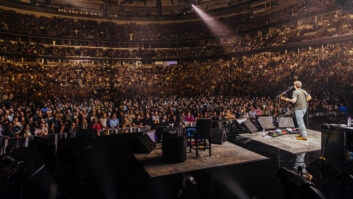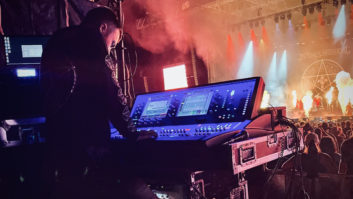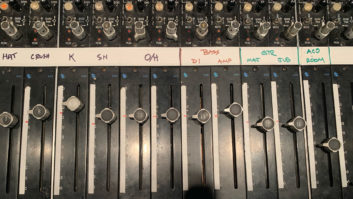
Photo: Candace Horgan
It’s late in John Mayer’s set at his second consecutive sellout night at Red Rocks in Morrison, Colo. Mayer has had the crowd wrapped around his finger for most of the night, mixing in anecdotes about recovering from damage to his vocal cords that limited his ability to hit certain notes to making peace with the song “Your Body Is a Wonderland.” Mayer’s band, which includes guitarists Doug Pettibone and Zane Carney, is tight and has followed Mayer wherever he goes musically.
Coming out of “Queen of California,” Mayer takes a jam abruptly into the Grateful Dead’s “Althea.” Wielding his guitar on a long solo, Mayer finishes furiously while Aaron Sterling’s kick drum roars from the Clair BT-218 subs. Standing at front of house, you can feel the bass hit you in a way that rarely happens at a big show.
“Some days, we pound the hell out of them,” laughs Mayer’s front-of-house engineer, Chad Franscoviak, of the subs. “We have 24 subs; most are flown.”
Mayer was touring the U.S. this summer prior to the release of his new album, Paradise Valley, in August. The sound crew for the tour consisted of Franscoviak, monitor engineer Bill Chrysler, systems tech Scott Frey, monitor tech Aeriel Gendler, and P.A. techs Dave Weisman and Matt Van Hook from Clair Global.
Franscoviak has been with Mayer for a long time. He met the singer-songwriter while working as a freelance studio engineer in Atlanta, and engineered several of his albums before becoming FOH engineer. He still engineers most of Mayer’s album projects, which gives him an advantage when mixing live.

Monitor tech Ariel Gendler (left) and monitor engineer Bill Chrysler
Photo: Candace Horgan
Handling monitor duties is Bill Chrysler, who has an interesting connection on the Mayer production side.
“I think in the late ‘70s I did Tom Petty and The Heartbreakers,” Chrysler recalls. “Right after that was a band called Roxy Music, and Chris Adamson, the production manager for John now, was the production manager for Roxy Music back then.”
Both Franscoviak and Chrysler are using Avid VENUE desks, and both use the D-Show surfaces. “Chad does a lot of Pro Tools in every show, and it’s easy for him to do a soundcheck,” Chrysler says. “For me, I’m at the maximum I can do with this desk, and if we do anything from here on out, I’ll need more outputs. We’ve grown with the desks, and are pretty much using them to their full capabilities.” “I wouldn’t use it if I didn’t like how it sounded,” Franscoviak explains. “Since we started touring, I’ve multitracked every show, and this sort of seamless integration with Pro Tools is fantastic. Because I engineer John’s records, I know what I used to get certain sounds, and I can re-create it pretty quickly. I use some of the same plug-ins live that I use in the studio. I like the ergonomics of it, too. I wish it had more outputs, I wish it had more inputs, I wish that it had more VCAs, but I feel confident that they are going to come out with something soon that will add to what is already there.”
While Franscoviak is using several plug-ins from the console, he still uses two outboard pieces: a Universal Audio 1176 LN limiting amplifier for Mayer’s vocal and an API 2500 bus compressor for a drum subgroup. He also uses the 1176 in the studio.
“His voice and the 1176 are a good combination,” Franscoviak says. “It is a pretty roadworthy unit. I like to be able to grab controls when I can and not have to go through pages to get to things. Vocals and drums tend to be more of the prominent things in the mix, so I like to be able to get my hands on them pretty quickly, and I like to be able to look over and see what is happening instead of having to go to certain pages. I like the visual immediacy of it.

Systems tech Scott Frey (left) and FOH engineer Chad Franscoviak
Photo: Candace Horgan
“For plug-ins, I use the [Crane Song] Phoenix stuff, I use a lot of classic compressors, the SSLs and the APIs and Fairchilds. If you look at my plug-ins rack, it’s pretty much just those. I use the Waves DeEsser, and the Eventide reverbs are great. I use a couple of harmonizer plug-ins too—one for a vocal and one for a widener. I use that if I want something to get out of the way of other instruments, as it gives it a place to live. I use the channel strip delay a bit to get them in phase. Bill can’t do this stuff because he’s onstage, but I can.”
Adds Chrysler, “I’d like to, but with the in-ears, you just can’t afford to do it with the latency. On John’s, I use a Fairchild on his output. I have the standard Waves package to do everything.” While Mayer has four wedges onstage, he mostly uses in-ears, as does the rest of the band.
“His footprint is the same,” explains Chrysler. “Even when he does the trio, we have the same setup for him. The two inside wedges are just for his vocal, and the outside wedges get mostly instruments, a little bit of vocal, some backup stuff. John likes to connect with the audience, so sometimes he will pull one in-ear out, and if he does that, I put a unity gain on those wedges. Otherwise, I run back about 20, 25 percent and try to keep it as clean as I can for Chad out front. We are using SRM wedges, the old Showco stuff. A lot of the time, he doesn’t use the wedges, but it’s his space. He always has those wedges, his pedals the same way, the same setup on his microphone. If we swing into a trio thing, he doesn’t use ears at all; then we use the wedges. We always put them out, but probably 80 percent of the time, maybe more, when he is doing the full band, he’s only on the ears and the wedges are just backup. For ears, he uses Jerry Harvey JH16s. The rest of the band is also using only ears, and Aaron, our drummer, has a sub, but that’s the only other conventional speaker onstage.”
Out front, Franscoviak mixes in stereo, but makes sure that no matter where a listener is, he or she can hear all the players.
“I used to experiment with putting the far house right P.A. in the side-hang left P.A., but realistically, I don’t pan that wide,” he says. “When the stage-right guitar player is soloing, everyone is going to hear it. This band keeps you on your toes. We do run snapshots, but John changes the set every night. We are changing snare drums every song, guitars every song, and there are a lot of levels thrown at us. We do use snapshots, but they never play the same song the same way twice. John is always throwing solos out to different people off the cuff, he is always rearranging songs on the spot, he’s always playing a new song that we’ve never rehearsed before in the middle of a set, so you just have to give in to it. There’s never a section of the set where I’m not on his vocal fader and not on whatever I can reach with my other hand.”
“John also calls audibles a lot,” Chrysler chimes in. “It will be a song we know, but the band isn’t actually on the instruments on the song they are going into, so they will play the song just on what they are on, and we can’t go to the snapshot for that song. I keep a jam snapshot, too. You can make any changes to it and it won’t make any changes to your existing snapshots. It’s mixing on the fly.”

Photo: Candace Horgan
The microphone setup is pretty simple, consisting mainly of beyerdynamic M 88s and a series of Radial DIs for the keyboards and acoustic guitars.
“We use Shure Beta 58s on vocals, Neumann KM 184s on overheads, and then Shure 57s on snare top and bottom,” Franscoviak says. “We have some Royers on the Leslie, and a 421 on the bottom of the Leslie. We have a Subkick. Attention Yamaha: build an attractive Subkick, ’cause I like using it but I hate looking at it. It’s literally M 88s on bass drum, tom toms, guitar amplifiers, the horn players when we have them. John is just using a Beta 58 for vocals. We also have a beyer M 160 on the percussion for the background singers. We’ve tried every microphone, and there’s always something we like about it and something we dislike about it. I am a huge believer that if something works well, I am not a big experimenter. I really like keeping things simple and consistent.”
For this tour, the crew is using a Clair i-5 system with 12 i-5s a side, eight BT-218 subs flown and four more per side on the ground, and then six FF-2s for front fills. For bigger venues, they can also add six more i-5s a side for side hangs. Initial tuning of the system is done by Scott Frey.
“Chad and I aren’t heavy with SMAART,” Frey says. “We just use it as an analyzer for RTA. There are a couple of songs we use, and pink noise, to get the system as balanced as possible. We also when needed can flatten out the top speakers to better hit the lawn in sheds, as well as the high seats.”
After Frey has done the main tuning, Franscoviak will fine-tune it, usually by playing a recording from the previous night’s show.
“I like to come in after he has done an initial tune on the system,” Franscoviak says. “If I spend too long on it, I don’t want to go down a wormhole. I want to walk in with him feeling like he’s in a good spot, and then I can say, ‘I think you are really close; here is what I hear.’ I’ll play a song from the previous night’s show. It’s immediately familiar, and I know what it should sound like. If I want to touch up mixes, I’ll listen on near-fields, but when I go to the system, I’ll know how it should sound in relation to how it sounds on my near fields, and then I can make any changes and see how the room is reacting. It’s another upside of the VENUE system; it’s so easy to do all of those things. I can make any adjustments I want and then apply it to my mix right then.”







